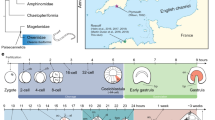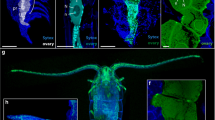Abstract
According to the ‘Articulata’ hypothesis the cleavage of arthropods must be derived from spiral cleavage. However, arthropods show a great variety of cleavage modes with a widespread occurrence of superficial cleavage. In the Malacostraca, holoblastic cleavage occurs in some taxa such as Amphipoda, Euphausiacea and Dendrobranchiata. In particular, the cleavage of euphausiaceans has been proposed to be a modified spiral cleavage. The cell lineage of early stages up to blastoderm formation of the euphausiacean Meganyctiphanes norvegica is reconstructed using recent methods of fluorescent staining. Only the oblique angle of the mitotic spindles during the transition from the 2- to the 4-cell stage resembles the spiral cleavage mode. At the 8-cell stage, four cells each form a pattern of two interlocking bands which is preserved until the 122-cell stage. One blastomere is delayed in division and shows an oblique division from the fourth cleavage on. It is the precursor cell of two enlarged and cleavage-arrested cells at the 32-cell stage. At the 62-cell stage, these two cells are surrounded by eight cells following a specific cell division pattern during the subsequent division cycles. The cleavage pattern of M. norvegica occurs in two mirror images. A comparative approach reveals distinct similarities between the early cleavage patterns of Euphausiacea and Dendrobranchiata which are suggested to be homologous. Furthermore, the relationships to non-malacostracan cleavage patterns are discussed. It is shown that the early cleavage pattern of M. norvegica does not offer an example of a spiral cleavage within arthropods.





Similar content being viewed by others
References
Aguinaldo AMA, Turbeville JM, Linford LS, Rivera MC, Garey JR, Raff RA, Lake JA (1997) Evidence for a clade of nematodes, arthropods and other moulting animals. Nature 387:489–493
Anderson DT (1969) On the embryology of the cirripede crustaceans Tetraclita rosea (Krauss), Tetraclita purpurascens (Wood), Chthamalus antennatus Darwin and Chamaesipho columna (Sprengler), and some considerations of crustacean phylogenetic relationships. Philos Trans R Soc B 256:183–235
Anderson DT (1973) Embryology and phylogeny in annelids and arthropods. Pergamon Press, Oxford
Brooks WK (1882) Leucifer. A study in morphology. Philos Trans R Soc B 173:57–137
Butschinsky P (1897) Die Furchung des Eies und die Blastodermbildung der Nebalia. Zool Anz 20:219–220
Dohle W (1970) Die Bildung und Differenzierung des postnauplialen Keimstreifs von Diastylis rathkei (Crustacea, Cumacea). I. Die Bildung der Teloblasten und ihrer Derivate. Z Morphol Ökol Tiere 67:307–392
Dohle W (1979) Vergleichende Entwicklungsgeschichte des Mesoderms bei Articulaten. Fortschr Zool Syst Evolutionsforsch 1:120–140
Dohle W (1989) Zur Frage der Homologie ontogenetischer Muster. Zool Beitr (N.F.) 32:355–389
Dohle W, Scholtz G (1988) Clonal analysis of the crustacean segment: the discordance between genealogical and segmental borders. Development 104(suppl):147–160
Dohle W, Scholtz G (1997) How far does cell lineage influence cell fate specification in crustacean embryos? Semin Cell Dev Biol 8:379–390
Freeman G (1983) The role of egg organization in the generation of cleavage patterns. In: Jeffery WR, Raff RA (eds) Time, space, and pattern in embryonic development. MBL Lectures in Biology, New York, pp 171–196
Fuchs K (1914) Die Keimblätterentwicklung von Cyclops viridis Jurine. Zool Jahrb Anat 38:103–156
George RY, Strömberg J-O (1985) Development of eggs of Antarctic krill Euphausia superba in relation to pressure. Polar Biol 4:125–133
Gerberding M, Browne WE, Patel NH (2002) Cell lineage analyses of the amphipod crustacean Parhyale hawaiensis reveals an early restriction of cell fates. Development 129:5789–5801
Giribet G, Distel DL, Polz M, Sterrer W, Wheeler WC (2000) Triploblastic relationships with emphasis on the acoelomates and the position of Gnathostomulida, Cycliophora, Plathelminthes and the Chaetognatha: a combined approach of 18S rDNA sequences and morphology. Syst Biol 49:539–562
Gorham FP (1895) The cleavage of the egg of Virbius zostericola, Smith. J Morphol 11:741–746
Groepler W (1986) Die Entwicklung bei Pomatoceros triqueter L. (Polychaeta, Serpulidae) vom befruchteten Ei bis zur schwimmenden Blastula. Zool Beitr (NF) 29:157–172
Hertzler PL (2002) Development of the mesendoderm in the dendrobranchiate shrimp Sicyonia ingentis. Arthropod Struct Dev 31:33–49
Hertzler PL, Clark WH (Jr) (1992) Cleavage and gastrulation in the shrimp Sicyonia ingentis: invagination is accompanied by oriented cell division. Development 116:127–140
Hertzler PL, Wang SW, Clark WH Jr (1994) Mesendoderm cell and archenteron formation in isolated blastomeres from the shrimp Sicyonia ingentis. Dev Biol 164:333–344
Hickman VV (1937) The embryology of the syncarid crustacean, Anaspides tasmaniae. Pap Proc R Soc Tasmania 1936:1–35
Jarman SN, Nicol S, Elliott NG, McMinn A (2000) 28S rDNA evolution in the Eumalacostraca and the phylogenetic position of krill. Mol Phylogenet Evol 17:26–36
Kajishima T (1951) Development of isolated blastomeres of Penaeus japonicus. Zool Mag 60:258–262
Komaki Y (1966) Technical notes on keeping euphausiids live in the laboratory, with a review of experimental studies on euphausiids. Inf Bull Plankt Japan 13:95–105
Kühn A (1912) Die Sonderung der Keimesbezirke in der Entwicklung der Sommereier von Polyphemus pediculus de Geer. Zool Jahrb Anat Tiere 35:243–340
Luetjens CM, Dorresteijn AWC (1995) Multiple, alternative cleavage patterns precede uniform larval morphology during normal development of Dreissena polymorpha (Mollusca, Lamellibranchia). Roux’s Arch Dev Biol 205:138–149
Manton SM (1928) On the embryology of a mysid crustacean Hemimysis lamornae. Philos Trans R Soc Lond B 216:363–463
Manton SM (1934) On the embryology of Nebalia bipes. Philos Trans R Soc Lond B 223:168–238
McMurrich JP (1895) Embryology of the isopod Crustacea. J Morphol 11:63–154
Nielsen C (2001) Animal evolution: interrelationships of the living phyla, 2nd edn. Oxford University Press, Oxford
Richter S, Scholtz G (2001) Phylogenetic analysis of the Malacostraca (Crustacea). J Zool Syst Evol Res 39:113–136
Sars GO (1898) On the propagation and early development of Euphausiidae. Arch Math Natur Kristiania. 20:Tafel 1–4
Schmidt-Rhaesa A, Bartolomaeus T, Lemburg C, Ehlers U, Garey JR (1998) The position of the Arthropoda in the phylogenetic system. J Morphol 238:263–285
Schnabel R, Hutter H, Moerman D, Schnabel H (1997) Assessing normal embryogenesis in Caenorhabditis elegans using a 4D microscope: variability of development and regional specification. Dev Biol 184:234–265
Scholtz G (1997) Cleavage, germ band formation and head segmentation: the ground pattern of the Euarthropoda. In: Fortey RA, Thomas RH (eds) Arthropod relationships. Chapman and Hall, London, pp 317–332
Scholtz G (2000) Evolution of the nauplius stage in malacostracan crustaceans. J Zool Syst Evol Res 38:175–187
Scholtz G (2002) The Articulata hypothesis: or what is a segment? Organ Divers Evol 2:197–215
Scholtz G, Dohle W (1996) Cell lineage and cell fate in crustacean embryos: a comparative approach. Int J Dev Biol 40:211–220
Scholtz G, Wolff C (2002) Cleavage, gastrulation, and germ disc formation of the amphipod Orchestia cavimana (Crustacea, Malacostraca, Peracarida). Contrib Zool 71:9–28
Schram FR, Hof CHJ (1998) Fossils and the interrelationships of major crustacean groups. In: Edgecombe GD (ed) Arthropod fossils and phylogeny. Columbia University Press, New York, pp 233–302
Shiino SM (1942) Studies on the Embryology of Squilla oratoria de Haan. Mem Coll Sci Kyoto University B 17:77–174
Shiino SM (1968) Arthropoda. In: Kumé M, Dan K (eds) Invertebrate embryology, vol 10. Nolit Publishing House, Belgrade, pp 333–388
Siewing R (1963) Studies in malacostracan morphology: results and problems. In: Whittington HB, Rolfe WDI (eds) Phylogeny and evolution of Crustacea. Museum of Comparative Zoology, special publ. Massachusetts University Press, Cambridge, pp 85–110
Siewing R (1969) Lehrbuch der vergleichenden Entwicklungsgeschichte der Tiere. Parey, Hamburg
Siewing R (1979) Homology of cleavage-types? Fortschr Zool Syst Evolutionsforsch 1:7–18
Strömberg J-O (1965) On the embryology of the isopod Idotea. Ark Zool 17:421–473
Strömberg J-O (1971) Contribution to the embryology of bopyrid isopods with special reference to Bopyroides, Hemiarthrus and Pseudione (Isopoda, Epicarida). Sarsia 47:1–46
Taube E (1909) Beiträge zur Entwicklungsgeschichte der Euphausiden. I. Die Furchung des Eies bis zur Gastrulation. Z Wiss Zool 92:427–464
Taube E (1915) Beiträge zur Entwicklungsgeschichte der Euphausiden. II. Von der Gastrula bis zum Furciliastadium. Z Wiss Zool 114:577–656
Wägele JW, Misof B (2001) On quality of evidence in phylogeny reconstruction: a reply to Zrzavý’s defence of the ‘Ecdysozoa’-hypothesis. J Zool Syst Evol Res 39:165–176
Wägele JW, Erikson T, Lockhart P, Misof B (1999) The Ecdysozoa: artifact or monophylum? J Zool Syst Evol Res 37:211–223
Wang SW, Griffin FJ, Clark WH Jr (1997) Cell–cell association directed mitotic spindle orientation in the early development of the marine shrimp Sicyonia ingentis. Development 124:773–780
Watling L (1999) Toward understanding the relationships of the peracaridan orders: the necessity of determining exact homologies. In: Schram FR, von Vaupel Klein JC (eds) Crustaceans and the biodiversity crisis. Brill, Leiden, pp 73–89
Weldon WFR (1892) The formation of the germ-layers in Crangon vulgaris. Q J Microsc Sci 33:343–363
Weygoldt P (1963) Beitrag zur Kenntnis der Ontogenie der Dekapoden: Embryologische Untersuchungen an Palaemonetes varians (Leach). Zool Jahrb Anat 79:223–270
Weygoldt P (1986) Arthropod interrelationships: the phylogenetic-systematic approach. Z Zool Syst Evolutionsforsch 24:19–35
Wills MA (1998) Crustacean disparity through the Phanerozoic: comparing morphological and stratigraphic data. Biol J Linn Soc 65:455–500
Wolff C, Scholtz G (2002) Cell lineage, axis formation, and the origin of germ layers in the amphipod crustacean Orchestia cavimana. Dev Biol 250:44–58
Zilch R (1974) Die Embryonalentwicklung von Thermosbaena mirabilis Monod (Crustacea, Malacostraca, Pancarida). Zool Jahrb Anat 93:462–576
Zilch R (1975) Etappen der Frühontogenese von Thermosbaena mirabilis Monod (Crustacea, Malacostraca, Pancarida). Verh Dtsch Zool Ges 1974:121–126
Zilch R (1978) Embryologische Untersuchungen an der holoblastischen Ontogenese von Penaeus trisulcatus Leach (Crustacea, Decapoda). Zoomorphologie 90:67–100
Zilch R (1979) Cell lineage in arthropods? Fortschr Zool Syst Evolutionsforsch 1:19–41
Acknowledgements
We are grateful to Jarl-Ove Strömberg and the staff of the Kristineberg Marine Research Station (KMRS) for their great help and efforts in collecting Meganyctiphanes norvegica. We also want to thank Heinz Gert de Couet (University of Hawaii) for critically going through the manuscript. This work was supported by the Swedish Royal Academy of Sciences and by grants of the European Union (TMR) and of the Deutsche Forschungsgemeinschaft (DFG Scho 442/5-3).
Author information
Authors and Affiliations
Corresponding author
Rights and permissions
About this article
Cite this article
Alwes, F., Scholtz, G. Cleavage and gastrulation of the euphausiacean Meganyctiphanes norvegica (Crustacea, Malacostraca). Zoomorphology 123, 125–137 (2004). https://doi.org/10.1007/s00435-004-0095-6
Received:
Accepted:
Published:
Issue Date:
DOI: https://doi.org/10.1007/s00435-004-0095-6




